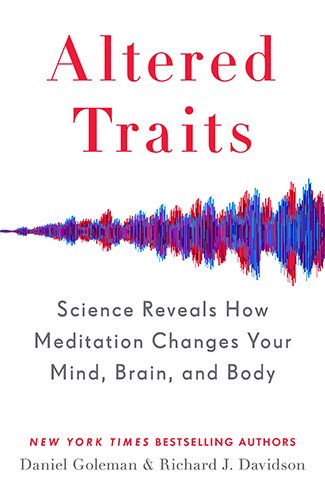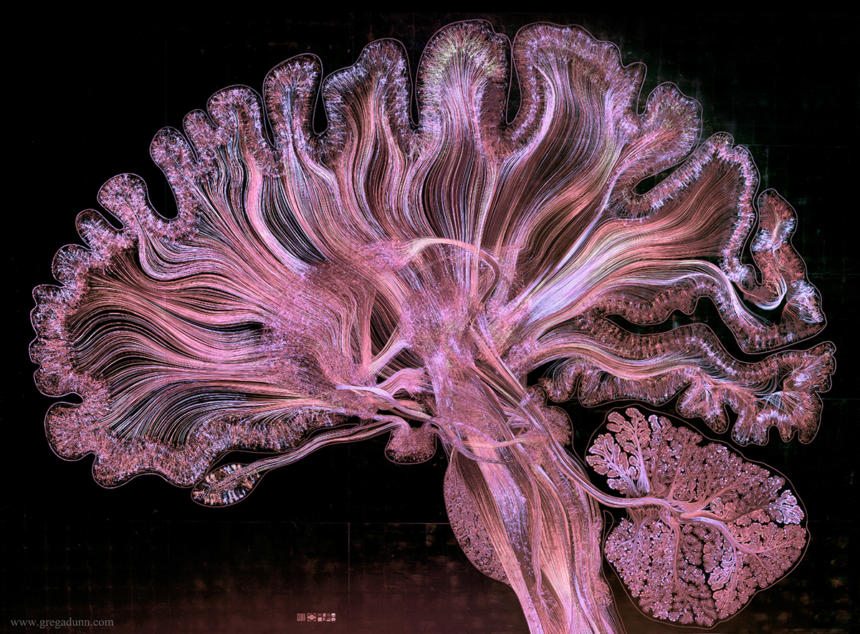Altering Traits
More lifetime hours spent meditating leads to more enduring benefits for practitioners.
By Daniel Goleman and Richard J. Davidson“In the beginning nothing comes, in the middle nothing stays, in the end nothing goes.” That enigmatic riddle comes from Jetsun Milarepa, Tibet’s eminent twelfth-century poet, yogi, and sage.
Matthieu Ricard unpacks Milarepa’s puzzle this way: at the start of contemplative practice, little or nothing seems to change in us. After continued practice, we notice some changes in our way of being, but they come and go. Finally, as practice stabilizes, the changes are constant and enduring, with no fluctuation. They are altered traits.
Taken as a whole, the data on meditation track a rough vector of progressive transformations, from beginners through the long-term meditators and on to the yogis. This arc of improvement seems to reflect both lifetime hours of practice as well as time on retreat with expert guidance.
The studies of beginners typically look at the impacts from under 100 total hours of practice—and as few as 7. The long-term group, mainly vipassana meditators, had a mean of 9,000 lifetime hours (the range ran from 1,000 to 10,000 hours and more).
And the yogis studied in Richie’s lab, had all done at least one Tibetan-style three-year retreat, with lifetime hours up to Mingyur’s 62,000. Yogis, on average had three times more lifetime hours than did long-term meditators—9,000 hours versus 27,000.
 A few long-term vipassana meditators had accumulated more than 20,000 lifetime hours and one or two up to 30,000, though none had done a three-year retreat, which became a de facto distinguishing feature of the yogi group. Despite the rare overlaps in lifetime hours, the vast majority of the three groups fall into these rough categories.
A few long-term vipassana meditators had accumulated more than 20,000 lifetime hours and one or two up to 30,000, though none had done a three-year retreat, which became a de facto distinguishing feature of the yogi group. Despite the rare overlaps in lifetime hours, the vast majority of the three groups fall into these rough categories.
There are no hard-and-fast lifetime hour cutoffs for the three levels, but research on them has clustered in particular ranges. We’ve organized meditation’s benefits into three dose-response levels, roughly mapping on the novice to amateur to professional rankings found in expertise of all kinds, from ballerinas to chess champions.
The vast majority of meditators in the West fall into the first level: people who meditate for a short period—a few minutes to half an hour or so on most days. A smaller group continues on to the long-term meditator level. And a mere handful attain the expertise of the yogis.
Let’s look at the impacts in those who have just begun a meditation practice. When it comes to stress recovery, the evidence for some benefits in the first few months of daily practice are more subjective than objective—and shaky. On the other hand the amygdala, a key node in the brain’s stress circuitry, shows lessened reactivity after thirty or so hours over eight weeks of MBSR practice.
Compassion meditation shows stronger benefits from the get-go; as few as seven total hours over the course of two weeks leads to increased connectivity in circuits important for empathy and positive feelings, and are strong enough to show up outside the meditation state per se. This is the first sign of a state morphing into a trait, though these effects likely will not last without daily practice. But the fact that they appear outside the formal meditation state itself may reflect our innate wiring for basic goodness.
Beginners also find improvements in attention very early on, including less mind-wandering after just eight minutes of mindfulness practice—a short-lived benefit, to be sure. But even as little as two weeks of practice is sufficient to produce less mind-wandering and better focus and working memory, enough for a significant boost in scores on the GRE, the entrance exam for graduate school. Indeed, some findings suggest decreases in activation in the self-relevant regions of the default mode with as little as two months of practice. When it comes to physical health, there is more good news: small improvements in the molecular markers of cellular aging seem to emerge with just thirty hours of practice.
Still, all such effects are unlikely to persist without sustained practice. Even so, these benefits strike us as surprisingly strong for beginners. Take-home: practicing meditation can pay off quickly in some ways, even if you have just started.

Courtesy of Greg Dunn
In the Long Term
Sticking with meditation over the years offers more benefits as meditators reach the long-term range of lifetime hours, around 1,000 to 10,000 hours. This might mean a daily meditation session, and perhaps annual retreats with further instruction lasting a week or so—all sustained over many years. The earlier effects deepen, while others emerge.
For example, in this range we see the emergence of neural and hormonal indicators of lessened stress reactivity. In addition, functional connectivity in the brain in a circuit important for emotion regulation is strengthened, and cortisol, a key hormone secreted by the adrenal gland in response to stress, lessens.
Loving-kindness and compassion practice over the long term enhance neural resonance with another person’s suffering, along with concern and a greater likelihood of actually helping. Attention, too, strengthens in many aspects with long-term practice: selective attention sharpens, the attentional blink diminishes, sustained attention becomes easier, and an alert readiness to respond increases. And long-term practitioners show enhanced ability to down-regulate the mind-wandering and self-obsessed thoughts of the default mode, as well as weakening connectivity within those circuits—signifying less self-preoccupation. These improvements often show up during meditative states, and generally tend to become traits.
Shifts in very basic biological processes, such as a slower breath rate, occur only after several thousand hours of practice. Some of these impacts seem more strongly enhanced by intensive practice on retreat than by daily practice.
While evidence remains inconclusive, neuroplasticity from long-term practice seems to create both structural and functional brain changes, such as greater working connection between the amygdala and the regulatory circuits in the prefrontal areas. And the neural circuits of the nucleus accumbens associated with “wanting” or attachment appear to shrink in size with longer-term practice.
While in general we see a gradient of shifts with more lifetime meditation hours, we suspect there are different rates of change in disparate neural systems. For instance, the benefits of compassion come sooner than does stress mastery. We expect studies in the future will fill in the details of a dose-response dynamic for various brain circuits.
Intriguing signs suggest that long-term meditators to some degree undergo state by trait effects that enhance the potency of their practice. Some elements of the meditative state, like gamma waves, may continue during sleep. And a daylong retreat by seasoned meditators benefited their immune response at the genetic level—a finding that startled the medical establishment.
Altered Traits in the Yogis
At this world-class level (roughly 12,000 to 62,000 lifetime hours of practice, including many years in deep retreat), truly remarkable effects emerge. Practice in part revolves around converting meditative states to traits— the Tibetan term for this translates as “getting familiar” with the meditative mind-set. Meditation states merge with daily activities, as altered states stabilize into altered traits and become enduring characteristics.
Here Richie’s group saw signs of altered traits in the yogi’s brain function and even structure, along with strongly positive human qualities. The jump in synchronized gamma oscillations initially observed during compassion meditation was also found, albeit to a lesser extent, in the baseline state. In other words, for the yogis this state has become a trait.
State by trait interactions mean what happens during meditation can be very different for the yogis, showing up starkly when compared with novices doing the same practice. Perhaps the strongest evidence comes from the yogis’ response to physical pain during simple mindfulness-type practice: a sharp “inverted V,” with little brain activity during anticipation of the pain, an intense but very short peak during the pain, followed by very rapid recovery.
For most of us who meditate, concentration takes mental effort, but for the yogis with most lifetime hours, it becomes effortless. Once their attention locks onto a target stimulus, their neural circuits for effortful attention go quiet while their attention stays perfectly focused.
When the yogis meditate on compassion there’s a strengthening of the coupling between heart and brain beyond what is ordinarily seen. Finally, there is that tantalizing bit of data showing shrinking in the nucleus accumbens in long-term meditators, suggesting we might find further structural changes in the yogi’s brain that support a lessening of attachment, grasping, and self-focus. Precisely what other such neural shifts there might be, and what they mean, await deciphering in future research.
Daniel Goleman is the New York Times bestselling author of the groundbreaking book Emotional Intelligence. A psychologist and science journalist, he reported on brain and behavioral research for The New York Times for many years is the author of more than a dozen books, including three accounts of meetings he has moderated between the Dalai Lama and scientists, psychotherapists, and social activists.
Richard J. Davidson, Ph.D., is the William James and Vilas Research Professor of Psychology and Psychiatry, director of the Waisman Laboratory for Brain Imaging and Behavior, and founder of the Center for Healthy Minds at the Waisman Center, University of Wisconsin, Madison.
Reprinted from Altered Traits: Science Reveals How Meditation Changes Your Mind, Brain, and Body by arrangement with Avery Books, a member of Penguin Group (USA) LLC, A Penguin Random House Company. Copyright © 2017, Daniel Goleman and Richard J. Davidson
Images courtesy of Greg Dunn. Read an interview with Greg Dunn, or learn more on his site gregadunn.com

I read information on Altered Traits. How amazing ! People say what will you get by simply closing eyes in medication? But explaining the effects of meditation hours spent on over all well-being of human from view point of medical sciences really a eye opener. Thanks for this. Great work. This will help make people in society more peaceful.
This was eye opening for me. I am self-taught and have been meditating regularly since I was a child, with a break of about ten years in my early 20s to early 30s. Since I restarted, I have cured myself from a supposedly incurable illness. Many other effects have also taken place, with some simply being more enhanced versions of what I had already gained as a child and teenager. The number of meditation hours laid out in this article is helping me make sense of it all — I think I have accumulated between 5000 to 10 000 hours. It is hard to tell, since I am often in a meditative state while doing average daily tasks. Thank you again for the article and information.